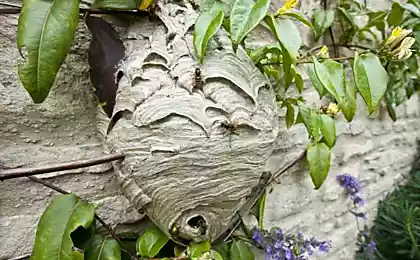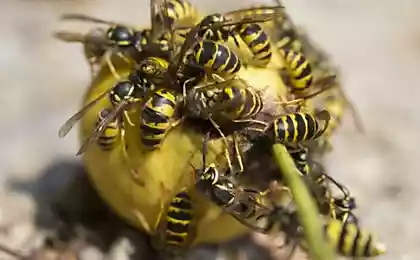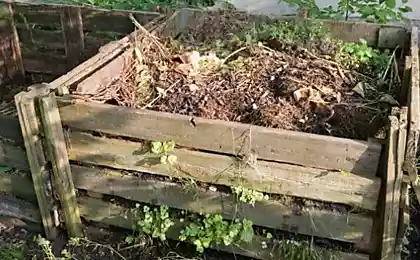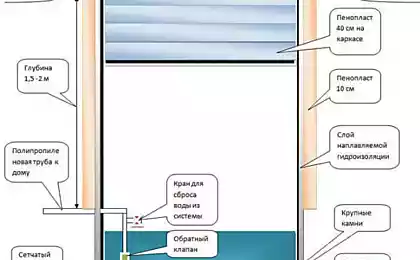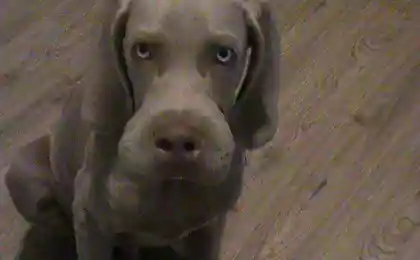305
How to get rid of wasps in the country
Here, it seems, and pests wasps can not be called, but annoying can not be worse. Until then, they are invisible, but in August they are irresistibly drawn to human housing - I suspect that the appetizing smells of jam and compotes. And then there is only one desire - to get rid of this scourge, and, as quickly and reliably as possible.
I had wasps built several small nests under the roof of the house and one huge one in the preban. Moreover, the “bath” nest grew literally before our eyes, until it reached completely intimidating dimensions. But as long as the inhabitants were peaceful and quiet, we coexisted with them safely. “You don’t touch us, we don’t touch you.” And here we go. . .
At first, these insects almost deprived us of the traditional Sabbath: a couple of weeks ago, they suddenly became aggressive. Then they began to overcome already in the house: little pleasant, when around you constantly circles with a dozen wasps. And they came to him, and he came to him with a bare foot and was stung. Murzik also tasted the aspen sting when trying to catch the insect. It was no longer possible to postpone the search for methods of struggle. . .
In practice, I experienced the simplest traps: containers with any sweet liquid. The conclusions are as follows:
It works - the wasps are baiting. But in this way, they will hardly be able to completely destroy them – only to reduce the “stock”. Or maybe distract from other “objects.” The container must have a narrow neck, preferably arranged on the principle of a funnel. Insects are taken into jars, bottles, and a basin of jam, but it is important that it is as difficult for them to get out of there as possible. The smelly liquid in the trap is preferable to ordinary sweet water - jam, honey, fermented liquids attract insects more. Thick viscous bait "catches" wasps better liquid. Suitable, for example, old jam (if candied, thickened strongly - a little diluted with water). I also found advice from an experienced vine grower: add an ampoule of any gastrointestinal insecticide to this liquid (means from the Colorado beetle, for example, are suitable). Says they don't fly far with a treat like that.
There are traps for factory wasps on sale, but they operate, in general, on the same principle as ordinary homemade ones, so if there are 5-10 minutes of free time, an unnecessary plastic bottle and “very skilled handles”, then there will be no need to go for such purchases.
But what I plan to look for in stores is a special poison for wasps. After eating such bait, the insect dies after a while. Moreover, taking a “feed” for relatives, the wasp carries destruction to other inhabitants of its nest. I have read some good reviews about RUBIT.
According to the reviews of summer residents, watermelon (version - melon) crusts, watered with insecticide without a pronounced odor (for example, Intavir) also help well. Such bait can be left in any suitable place - after eating poisonous food, wasps die.
Next, the question arises: what to do with the nest? If it is not destroyed, the wasps will breed safely, and I fear we will have to flee our own home. So I went in search of effective advice on how to get rid of the hornet nest. I'm sharing what I found.
It is quite logical: to get rid of a wasp nest in the summer is much more difficult than in the cold season. In autumn or spring, the empty dwelling is eliminated without any problems and risks to health (this is how large nests were removed from the ceiling beams in my house under construction).
If autumn is hard to wait, it is important to attack at the right time of day - at night. First, at this time the inhabitants of the nest of the house, and secondly, they are asleep. If you get rid of a half-empty nest during the day, you can forget peace for a long time: returned insects in search of their lost home can seriously poison the life of the offender.
Selection of strategy and “weapons” There are many options for destroying nests, but many of them involve serious risks. I will not try them, but for the most courageous (or desperate) still give, once I have found:
1. Water.
Someone advises boiling water (pour the nest, getting close to it), someone ordinary water (get to the hornet lair with a bucket of water and immerse the nest in it). Honestly, I have little idea how to do this if the insects are on a wall or in a corner. And under the roof (4 m in height, however!) to climb with a bucket of water or a hot kettle something does not pull.
2. Gasoline (kerosene, diesel, WD-40 and the like).
Any of these liquids are recommended to plentifully spray (you can from an ordinary garden sprayer) the aspen shelter - insects should die, and then we can easily remove the nest. I don’t like the fact that gasoline-kerosene-diesel is very flammable. And the house (and bath) is wooden. Anyway, I haven't had enough wasps yet.
By the way, there is information that kerosene on the wasps no longer acts as before. Whether kerosene is not the same, or insects mutated. But there is a risk of just angering them, and the desired effect is not achieved. And they say that winter diesel is more effective than summer (but where will you find it in August?). We need to stock up in advance. . .
The treatment of such a tool and its result can be seen in the next short plot (the sound, however, is bad, but the essence of the method is clear and without words).
3. Dichlorophos, domestos, chlorine... Household chemistry is advised to treat the hornet nest and places of insect accumulation. Someone recommends pre-putting a plastic bag on the nest, and already spray poison into it, someone suggests first generously watering the abode of wasps with the chosen remedy, and then packing.
In the first case, there is a high risk of being bitten during a “combat operation”. However, choosing the second option, you should also not relax: from such a "weapon" wasps do not die immediately, but for some time rush, biting everyone who turns up, so it will not be much easier to put a package on the nest.
In general, reviews are contradictory about dichlorophos: some are delighted with it, say that they solve the problem at the first attempt; others write that this remedy turned out to be useless. But the first is still noticeably more, and there is one pattern: failure usually befalls those who decided to use the “newfangled” version of the drug, the advantage of which manufacturers declare the absence of an unpleasant odor. The effect, as it turns out, is missing, too. Therefore, choosing dichlorophos as a means of combating, give preference to the traditional “smelling” option.
Summer residents also fight wasps with the help of deodorants, air fresheners and other fragrant aerosols (reading these tips, I immediately remembered how we in our youth in the student dormitory of cockroaches were taunted with hairspray) the guise is cunning. . .
The essence of the use of any household chemicals is approximately the same: destroy (or strongly intoxicate) the inhabitants of the nest, and then remove and burn it.
4. Specialized drugs
In my opinion, this is the most direct way to the cherished goal. Folk methods and improvised means are good if there are no special ones at hand and it is problematic to get them. If the problem is not “burning”, it may be better to postpone its solution until the next trip to the store. And there purposefully purchase (and then use as intended) one of the effective (according to the reviews of those who used) means: Alatar, Raptor from wasps, Troapsil, Smelnet, Ghetta, Mosquitol Protection from wasps and the like.
Plus, many of these drugs provide long-term protection, that is, not only destroy wasps here and now, but also prevent their appearance in the near future (up to 8 months, which is not at all small, agree, especially if the treatment is carried out not at the moment when the problem worsened, but in advance).
If the nest is not available, we have a problem. Because without destroying the wasp dwelling, we will not get rid of them completely. And they just do not settle for residence: in crevices under the floor, in metal pipes, under the skin of the walls - in any secluded corner.
If you turn your own habitation to get to the aspen, is not included in your plans, try to use the "advice of experienced": those who have faced this situation, recommend to start lime insects with the help of chemistry (the same dichlorophos is quite suitable, and specialized means - especially), and then tightly seal all the moves-outs leading to the nest. It is said that the stains are not the same as the stains of the eye.
You can remove the wasp from the shelter using a conventional vacuum cleaner, as the author of the following video does:
But this operation, as we can see, is quite unsafe, long and time-consuming, and the effect of it, according to the “inventor”, is very short-lived.
Going to battle with wasps, it is very important to remember about self-defense. The bites of these insects pose a real threat not only to health, but in some cases to life: if there is a predisposition to allergic reactions (about which you may not even guess), even one or two "pricks", harmless for an absolutely healthy person, enough for serious swelling, suffocation and other "pleasures", sending the victim straight to the intensive care unit.
When going to destroy the inhabited nest of wasps, be sure to take care of proper equipment: clothing made of dense fabric (and preferably with a hood), gloves (thick rubber or leather), mosquito net or other device for protecting the face.
If wasps live in the country, be sure to keep suprastin, adrenaline and prednisone in the first aid kit. Even if you and your family members are not allergic to bites, these precautions may not be superfluous. At hand in case of a bite should also be ice and a tourniquet. Why it matters, and how to take advantage of it, in the next video. Retelling the recommendations of a professional is a thankless occupation, so it is better to spend a few minutes watching, it is really important.
Do you have wasps in your country? What are you doing to get rid of them? What methods do you consider the most reliable and effective?
Source: www.7dach.ru
I had wasps built several small nests under the roof of the house and one huge one in the preban. Moreover, the “bath” nest grew literally before our eyes, until it reached completely intimidating dimensions. But as long as the inhabitants were peaceful and quiet, we coexisted with them safely. “You don’t touch us, we don’t touch you.” And here we go. . .
At first, these insects almost deprived us of the traditional Sabbath: a couple of weeks ago, they suddenly became aggressive. Then they began to overcome already in the house: little pleasant, when around you constantly circles with a dozen wasps. And they came to him, and he came to him with a bare foot and was stung. Murzik also tasted the aspen sting when trying to catch the insect. It was no longer possible to postpone the search for methods of struggle. . .
In practice, I experienced the simplest traps: containers with any sweet liquid. The conclusions are as follows:
It works - the wasps are baiting. But in this way, they will hardly be able to completely destroy them – only to reduce the “stock”. Or maybe distract from other “objects.” The container must have a narrow neck, preferably arranged on the principle of a funnel. Insects are taken into jars, bottles, and a basin of jam, but it is important that it is as difficult for them to get out of there as possible. The smelly liquid in the trap is preferable to ordinary sweet water - jam, honey, fermented liquids attract insects more. Thick viscous bait "catches" wasps better liquid. Suitable, for example, old jam (if candied, thickened strongly - a little diluted with water). I also found advice from an experienced vine grower: add an ampoule of any gastrointestinal insecticide to this liquid (means from the Colorado beetle, for example, are suitable). Says they don't fly far with a treat like that.
There are traps for factory wasps on sale, but they operate, in general, on the same principle as ordinary homemade ones, so if there are 5-10 minutes of free time, an unnecessary plastic bottle and “very skilled handles”, then there will be no need to go for such purchases.
But what I plan to look for in stores is a special poison for wasps. After eating such bait, the insect dies after a while. Moreover, taking a “feed” for relatives, the wasp carries destruction to other inhabitants of its nest. I have read some good reviews about RUBIT.
According to the reviews of summer residents, watermelon (version - melon) crusts, watered with insecticide without a pronounced odor (for example, Intavir) also help well. Such bait can be left in any suitable place - after eating poisonous food, wasps die.
Next, the question arises: what to do with the nest? If it is not destroyed, the wasps will breed safely, and I fear we will have to flee our own home. So I went in search of effective advice on how to get rid of the hornet nest. I'm sharing what I found.
It is quite logical: to get rid of a wasp nest in the summer is much more difficult than in the cold season. In autumn or spring, the empty dwelling is eliminated without any problems and risks to health (this is how large nests were removed from the ceiling beams in my house under construction).
If autumn is hard to wait, it is important to attack at the right time of day - at night. First, at this time the inhabitants of the nest of the house, and secondly, they are asleep. If you get rid of a half-empty nest during the day, you can forget peace for a long time: returned insects in search of their lost home can seriously poison the life of the offender.
Selection of strategy and “weapons” There are many options for destroying nests, but many of them involve serious risks. I will not try them, but for the most courageous (or desperate) still give, once I have found:
1. Water.
Someone advises boiling water (pour the nest, getting close to it), someone ordinary water (get to the hornet lair with a bucket of water and immerse the nest in it). Honestly, I have little idea how to do this if the insects are on a wall or in a corner. And under the roof (4 m in height, however!) to climb with a bucket of water or a hot kettle something does not pull.
2. Gasoline (kerosene, diesel, WD-40 and the like).
Any of these liquids are recommended to plentifully spray (you can from an ordinary garden sprayer) the aspen shelter - insects should die, and then we can easily remove the nest. I don’t like the fact that gasoline-kerosene-diesel is very flammable. And the house (and bath) is wooden. Anyway, I haven't had enough wasps yet.
By the way, there is information that kerosene on the wasps no longer acts as before. Whether kerosene is not the same, or insects mutated. But there is a risk of just angering them, and the desired effect is not achieved. And they say that winter diesel is more effective than summer (but where will you find it in August?). We need to stock up in advance. . .
The treatment of such a tool and its result can be seen in the next short plot (the sound, however, is bad, but the essence of the method is clear and without words).
3. Dichlorophos, domestos, chlorine... Household chemistry is advised to treat the hornet nest and places of insect accumulation. Someone recommends pre-putting a plastic bag on the nest, and already spray poison into it, someone suggests first generously watering the abode of wasps with the chosen remedy, and then packing.
In the first case, there is a high risk of being bitten during a “combat operation”. However, choosing the second option, you should also not relax: from such a "weapon" wasps do not die immediately, but for some time rush, biting everyone who turns up, so it will not be much easier to put a package on the nest.
In general, reviews are contradictory about dichlorophos: some are delighted with it, say that they solve the problem at the first attempt; others write that this remedy turned out to be useless. But the first is still noticeably more, and there is one pattern: failure usually befalls those who decided to use the “newfangled” version of the drug, the advantage of which manufacturers declare the absence of an unpleasant odor. The effect, as it turns out, is missing, too. Therefore, choosing dichlorophos as a means of combating, give preference to the traditional “smelling” option.
Summer residents also fight wasps with the help of deodorants, air fresheners and other fragrant aerosols (reading these tips, I immediately remembered how we in our youth in the student dormitory of cockroaches were taunted with hairspray) the guise is cunning. . .
The essence of the use of any household chemicals is approximately the same: destroy (or strongly intoxicate) the inhabitants of the nest, and then remove and burn it.
4. Specialized drugs
In my opinion, this is the most direct way to the cherished goal. Folk methods and improvised means are good if there are no special ones at hand and it is problematic to get them. If the problem is not “burning”, it may be better to postpone its solution until the next trip to the store. And there purposefully purchase (and then use as intended) one of the effective (according to the reviews of those who used) means: Alatar, Raptor from wasps, Troapsil, Smelnet, Ghetta, Mosquitol Protection from wasps and the like.
Plus, many of these drugs provide long-term protection, that is, not only destroy wasps here and now, but also prevent their appearance in the near future (up to 8 months, which is not at all small, agree, especially if the treatment is carried out not at the moment when the problem worsened, but in advance).
If the nest is not available, we have a problem. Because without destroying the wasp dwelling, we will not get rid of them completely. And they just do not settle for residence: in crevices under the floor, in metal pipes, under the skin of the walls - in any secluded corner.
If you turn your own habitation to get to the aspen, is not included in your plans, try to use the "advice of experienced": those who have faced this situation, recommend to start lime insects with the help of chemistry (the same dichlorophos is quite suitable, and specialized means - especially), and then tightly seal all the moves-outs leading to the nest. It is said that the stains are not the same as the stains of the eye.
You can remove the wasp from the shelter using a conventional vacuum cleaner, as the author of the following video does:
But this operation, as we can see, is quite unsafe, long and time-consuming, and the effect of it, according to the “inventor”, is very short-lived.
Going to battle with wasps, it is very important to remember about self-defense. The bites of these insects pose a real threat not only to health, but in some cases to life: if there is a predisposition to allergic reactions (about which you may not even guess), even one or two "pricks", harmless for an absolutely healthy person, enough for serious swelling, suffocation and other "pleasures", sending the victim straight to the intensive care unit.
When going to destroy the inhabited nest of wasps, be sure to take care of proper equipment: clothing made of dense fabric (and preferably with a hood), gloves (thick rubber or leather), mosquito net or other device for protecting the face.
If wasps live in the country, be sure to keep suprastin, adrenaline and prednisone in the first aid kit. Even if you and your family members are not allergic to bites, these precautions may not be superfluous. At hand in case of a bite should also be ice and a tourniquet. Why it matters, and how to take advantage of it, in the next video. Retelling the recommendations of a professional is a thankless occupation, so it is better to spend a few minutes watching, it is really important.
Do you have wasps in your country? What are you doing to get rid of them? What methods do you consider the most reliable and effective?
Source: www.7dach.ru
Intense exercise is useful after heart transplantation
The thermoelectric generator will return the car lost power + video

